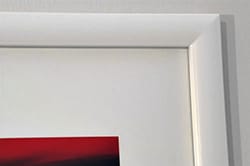Framing Behind Glass: methods + materials
traditional conservation / archival framing
|
Preservation/Conservation/Archival Framing is a method of picture framing that protects and preserves artwork. If artwork is not properly framed in this way, it can quickly succumb to the damaging effects of light, humidity, acid in the framing materials, dust or insects. Be sure to take an unframed artwork to a professional picture framer, trained in the proper techniques and materials for archival framing, to ensure the protection of your artwork for many generations.
|
matting
|
The real purpose of matting, besides it’s aesthetic use, is that it creates an air space between the art and the glazing. This space helps to dissipate moisture and thus prevent the art from becoming fused to the glass.
Always use archival quality, acid-free mounting boards: e.g. the “Alphamat Artcare” System from Nielsen-Bainbridge. Your framer will be ready to advise on colour but consider the mat as the visual bridge, along with the frame, between the picture and it's environment. When the future location is unknown, our preference is for a slightly off-white colour, as close a colour match to the paper as possible, in order to maintain a simple and elegant presentation which will not present décor conflicts |
acrylic spacers
|
For reasons of elegance and simplicity we like to use Acrylic Spacers hidden inside the frame rebate (attached to the glass, shown left ) to elevate the glazing off the artwork in place of a mat. To use acrylic spacers the paper size must be the same as the inside of the frame so as to go underneath the spacers, thereby being clamped between the spacer and the backing board. The image is precisely centred on the paper with generous borders, the paper being heavyweight holds its shape and lies/stays flat.
(Find out more in: Working With Standard Sizes...)
Archival quality linen hinges are used to attach the artwork to the backing or mount board, securing the artwork whilst ensuring it’s long-term integrity. Archival quality backing board or foamcore board, sealed with an aluminum tape (recommended), will protect your artwork from pollutants entering the back of the framed piece.
|
glass or acrylic / uv or not uv?
Ultraviolet light can fade, deteriorate or yellow artwork. UV glass and acrylic filters 97% of the harmful light (as compared to about 47% with regular glass), effectively doubling the life of the giclee prints from 100 to 200 years. The downside is, acrylic scratches easily and neither UV glass or acrylic come cheap.
what you can do to protect your artwork

Hang framed pictures on your wall. Not only can you enjoy your artwork, but also framed works do much better on the wall than in storage. Move artwork around occasionally to change the amount and direction of light exposure and keep your artwork out of direct sunlight, even with conservation glass or acrylic glazing.
Store your artwork carefully. Whenever possible, store artwork in a climate-controlled space similar to your living space. Where you are comfortable, it will be comfortable. Do not store artwork in an attic, a garage or a basement where temperature extremes and humidity will be damaging. If you notice signs of moisture within the frame, dismantle the frame carefully, removing backing board, artwork and any mat boards from the frame and allow them to dry properly. If the moisture is extensive or there are signs of mildew, take the artwork to a trained framing professional or picture conservator.
If you have any questions about framing your limited edition prints, please contact us.
Store your artwork carefully. Whenever possible, store artwork in a climate-controlled space similar to your living space. Where you are comfortable, it will be comfortable. Do not store artwork in an attic, a garage or a basement where temperature extremes and humidity will be damaging. If you notice signs of moisture within the frame, dismantle the frame carefully, removing backing board, artwork and any mat boards from the frame and allow them to dry properly. If the moisture is extensive or there are signs of mildew, take the artwork to a trained framing professional or picture conservator.
If you have any questions about framing your limited edition prints, please contact us.
exclusive contract framing
|
For contracts of sufficient size* we offer a complete traditional framing solution with custom mouldings designed and manufactured exclusively for you/your client.
Timber used from sustainable sources only. The mouldings illustrated on this page were designed by and manufactured under contract for Print Art Photography CA. Please contact us for a quote or to discuss your project. * Usually at least 20 units over 24"x 20" are needed to make this economically viable, e.g. decorating a hotel. |
|
Courtesy: Christina Stobbs, BC
|
Borders are provided to facilitate handling, matting and framing of the print.
They also provide a useful way to standardize your print sizes by accommodating images of different proportions, and standard sizes will streamline the marketing and selling of your prints... Left: 20"x 13.3" image (3:2) placed in a 24"x20" sheet of paper (6:5)
for standard exhibition frame or portfolio sleeve. |







